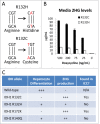IDH mutations in liver cell plasticity and biliary cancer
- PMID: 25485496
- PMCID: PMC4614372
- DOI: 10.4161/15384101.2014.965054
IDH mutations in liver cell plasticity and biliary cancer
Abstract
Intrahepatic cholangiocarcinoma (ICC) is an aggressive cancer associated with the bile ducts within the liver. These tumors are characterized by frequent gain-of-function mutations in the isocitrate dehydrogenase 1 and 2 (IDH1 and IDH2) genes-that are also common in subsets of neural, haematopoietic and bone tumors, but rare or absent in the other types of gastrointestinal malignancy. Mutant IDH acts through a novel mechanism of oncogenesis, producing high levels of the metabolite 2-hydroxyglutarate, which interferes with the function of α-ketoglutarate-dependent enzymes that regulate diverse cellular processes including histone demethylation and DNA modification. Recently, we used in vitro stem cell systems and genetically engineered mouse models (GEMMs) to demonstrate that mutant IDH promotes ICC formation by blocking hepatocyte differentiation and increasing pools of hepatic progenitors that are susceptible to additional oncogenic hits leading to ICC. We found that silencing of HNF4A-encoding a master transcriptional regulator of hepatocyte identity and quiescence-was critical to mutant IDH-mediated inhibition of liver differentiation. In line with these findings, human ICC with IDH mutations are characterized by a hepatic progenitor cell transcriptional signature suggesting that they are a distinct ICC subtype as compared to IDH wild type tumors. The role of mutant IDH in controlling hepatic differentiation state suggests the potential of newly developed inhibitors of the mutant enzyme as a form of differentiation therapy in a solid tumor.
Keywords: IDH1; IDH2; Isocitrate Dehydrogenase; cholangiocarcinoma; mouse models.
Figures




References
-
- Hezel AF, Deshpande V, Zhu AX. Genetics of biliary tract cancers and emerging targeted therapies. J Clin Oncol 2010; 28:3531-40; PMID:20547994; http://dx.doi.org/10.1200/JCO.2009.27.4787 - DOI - PMC - PubMed
-
- Razumilava N, Gores GJ. Cholangiocarcinoma. Lancet; 383:2168-79; PMID:24581682; http://dx.doi.org/10.1016/S0140-6736(13)61903-0 - DOI - PMC - PubMed
-
- Borger DR, Tanabe KK, Fan KC, Lopez HU, Fantin VR, Straley KS, Schenkein DP, Hezel AF, Ancukiewicz M, Liebman HM, et al. . Frequent Mutation of Isocitrate Dehydrogenase (IDH)1 and IDH2 in Cholangiocarcinoma Identified Through Broad-Based Tumor Genotyping. Oncol 2012; 17:72-9; http://dx.doi.org/10.1634/theoncologist.2011-0386 - DOI - PMC - PubMed
-
- Chan-on W, Nairismagi M-L, Ong CK, Lim WK, Dima S, Pairojkul C, Lim KH, McPherson JR, Cutcutache I, Heng HL, et al. . Exome sequencing identifies distinct mutational patterns in liver fluke-related and non-infection-related bile duct cancers. Nat Genet 2013; 45:1474-8; PMID:24185513; http://dx.doi.org/10.1038/ng.2806 - DOI - PubMed
-
- Jiao Y, Pawlik TM, Anders RA, Selaru FM, Streppel MM, Lucas DJ, Niknafs N, Guthrie VB, Maitra A, Argani P, et al. . Exome sequencing identifies frequent inactivating mutations in BAP1, ARID1A and PBRM1 in intrahepatic cholangiocarcinomas. Nat Genet 2013; 45:1470-3; PMID:24185509; http://dx.doi.org/10.1038/ng.2813 - DOI - PMC - PubMed
Publication types
MeSH terms
Substances
Grants and funding
LinkOut - more resources
Full Text Sources
Other Literature Sources
Medical
Miscellaneous
